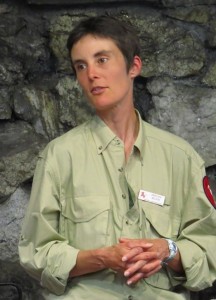With temperatures dropping below freezing again and the potential of heavy snowfall in the next days, spring is not the first thing that comes to mind. At least not to us humans. Songbirds on the other hand are already preparing for the next breeding season and spring may well be on their minds.
You may have heard the song of a Carolina Chickadee or Carolina Wren outside your window, often early in the morning when the temperatures are particularly frigid. For these resident birds it is important to defend a territory and after a long, cold night let everyone know that they are still alive and yes, the territory is still taken!
Did you know that almost 80% of our songbird species that commonly breed (and thus vocalize) in Ohio, maybe even in your backyard, do not spend the winter with us? You may not notice the dramatic decline in bird diversity, because some birds are replaced by winter visitors from the north. Sometimes even within a species, such as the American Robin.
Many of our summer American Robins move south while birds from more northern populations come to our area for the winter. So next time you see a robin in your garden, remember that it may not be the familiar bird whose song you enjoyed all summer. 
If you have a bird feeder in your backyard, you may be familiar with some of our regular winter visitors. Maybe you have noticed Dark-eyed Juncos and American Tree Sparrows among the more familiar residents such as Northern Cardinal and Carolina Chickadee. Have you seen any of the more irregular visitors yet such as Red-breasted Nuthatch or Pine Siskin? According to the Winter Finch Forecast – a report researched and written by Ron Pittaway of the Ontario Field Ornithologists each year since 1999 and published on the World Wide Web – we should be very lucky to see either of the aforementioned irregular visitors in large numbers at a feeder in Ohio this winter because of a heavy cone crop on Balsam Fir in many areas that should provide ample food for these birds in the areas north.
- Dark-eyed Junco
- American Tree Sparrow
- Red-breasted Nuthatch
- Pine Siskin
A few months ago even the hardy birds, who spend the winter in Ohio, were quiet. Walking through a woodland in December, you would have noticed how quiet nature can be, hardly any animals made a sound then. Still now the bird chorus is quite limited, you can easily count the species that join in. This is a good time to practice your birding by ear skills. Find your favorite birds on the website of the Borror Laboratory of Bioacoustics where you can listen online to hours of sounds. Or consider listening to nature’s music on one of our lab’s CDs with animal sounds – please contact the curator for details for any of the following CDs: Voices of Ohio Birds, Calls of Ohio Frogs and Toads, Sounds of Insects and Amphibiance, and for these produced in collaboration with ODNR – Common birds of Ohio, Warblers of Ohio, Waterbirds of Ohio and Owls of Ohio.
Our latest production is of birds commonly heard on and around Hog Island, Maine, a stark contrast to the other CDs that focus on animals in Ohio. Why Maine?

Don Borror teaching on Hog Island in 1940s © Friends of Hog Island
Don Borror, entomology professor and founder of the Borror lab, used to teach some of the Audubon summer programs on Hog Island, Maine through his retirement in 1977. For the past two springs I have been privileged to follow his footsteps and also teach on the island in the Muscongus Bay.
I have taught participants about the skill of ‘Birding by Ear’ as well as ‘How to make Audio Recordings of Bird Sounds’ (stay tuned for more about these topics in one of our future posts!).
To aid my instruction I put together a CD of sound recordings of species that we are likely to encounter on the island and along the coast of Maine. Each track starts with the common song of the species, followed by the identification and some more, often less commonly heard sounds. Participants have enjoyed listening to the sounds, many of them were recorded in the field by Don Borror.
I will be teaching again on Hog Island this year during the sessions Field Ornithology (12-17 June) and Hands-on Bird Science (19-24 June) – Registration is now open with an early bird discount until February 15th. Come join me on Hog Island!
About the Author: Angelika Nelson is curator of the Borror Laboratory of Bioacoustics at The Ohio State University. Photos taken by the author unless stated otherwise.







